Speakers are essential in any audio setup, whether for professional or casual use. But have you ever noticed how the sound changes depending on where you are and where the speakers are?
Proper placement and positioning of your speakers allow you to get the most out of their performance. The right speaker placement can dramatically improve your listening experience, even with low-end models. So here’s a complete guide to speaker placement for every type and number of speakers that you may have (even if you’ve got 11!).
The golden rule to remember is that sound is subjective. While there’s a science as to what sounds good and how to place your speakers and your listening spot accurately, it’s always each their own. Every environment is slightly different, and so is every set of ears. Just follow them while using this guide, and you’ll be good to go.
How to Setup Speakers Effectively
The optimal positional for speakers will depend on the number and type you have. Don’t worry, though; we have diagrams for all setups below. We also have a full guide with additional sound tips and tricks below the diagrams that you’ll want to read in order to learn how to get the most out of your sound system.
1 Speaker (Mono Sound System)
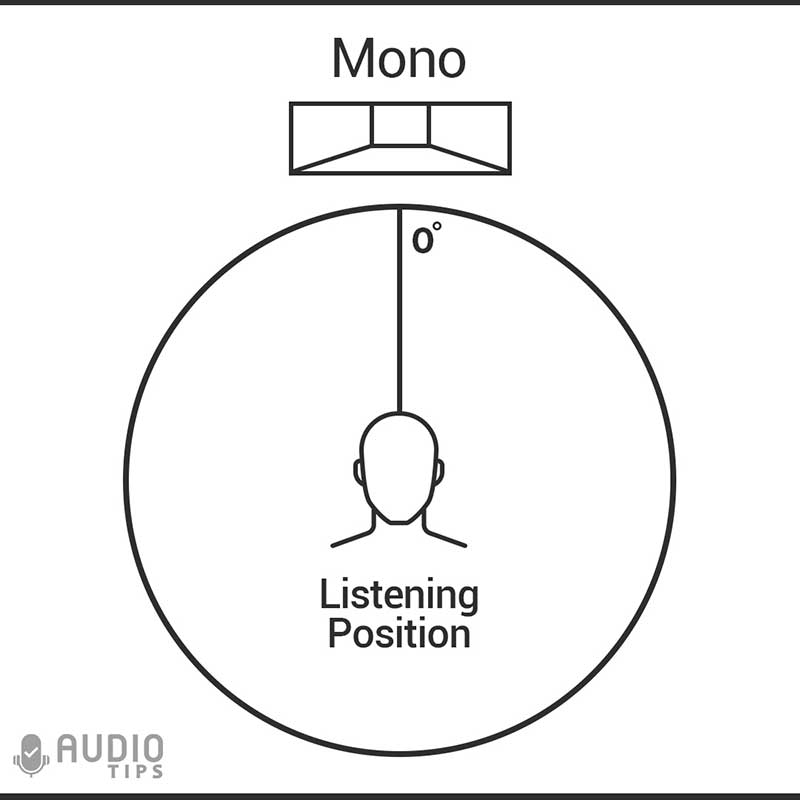
Mono, or monoaural sound, is a single-channel sound system. This means that you just have one speaker, which is responsible for producing all the sound frequencies that reach your ears.
So you should place the speaker in a position directly in front of your listening position at ear level. This will direct the sound directly at you and let you hear it clearly with minimal reverb.
2 Speakers or 2.1 Stereo System
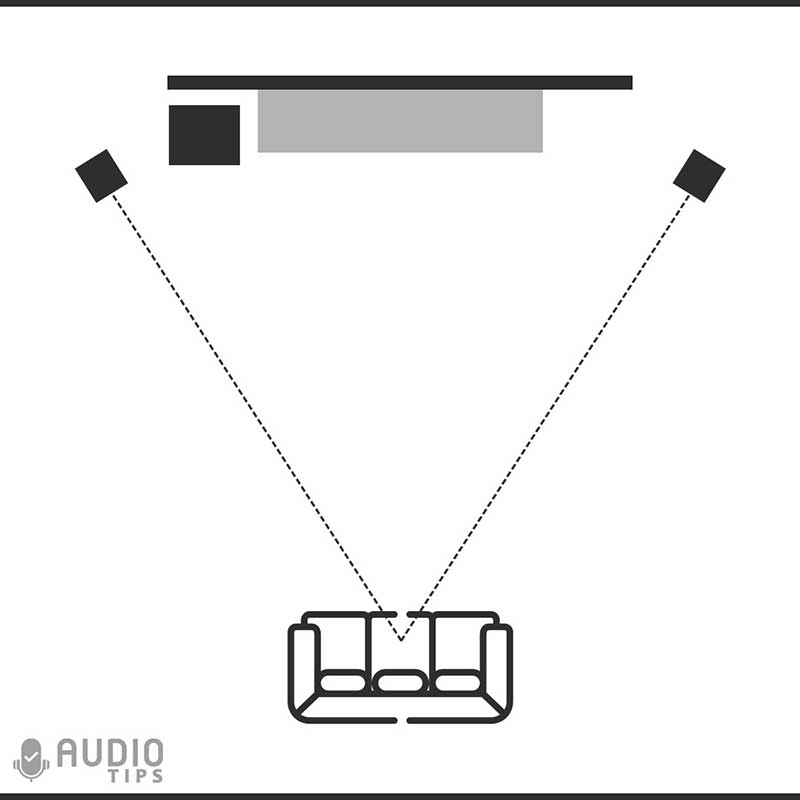
In a stereo or 2.1-channel setup, audio will be produced by the left and right speakers (two channels). If you just have two speakers without any subwoofers, you should place the speakers in the form of an equilateral triangle, with you being the third corner.
The distance between the speakers and their distance from your listening position should be approximately equal so the sound is optimal and doesn’t get muddy. The distance depends upon your layout, but don’t place them too far apart to avoid stereo width problems.
The height, as discussed previously, should be such that the placement of the tweeters matches the height of your ears when you are seated.
Besides the height and space, you also want to place the speakers at an angle toward you. This will let the audio waves reach directly and clearly into your ears for the best listening experience.
Subwoofer Placement
A subwoofer produces an omnidirectional sound, and technically, it can be placed anywhere in the room for the audio waves to reach your ears. But you avoid placing it directly in a corner or a partially enclosed space, such as a cabinet because this will make it sound boomy and overpowering.
Ideally, place them somewhere near the center of the two speakers in front of you. This will let you ‘feel’ the bass without being muddy. If the bass feels too heavy, just turn it down a bit or place it farther back.
3.1 Channel Sound System
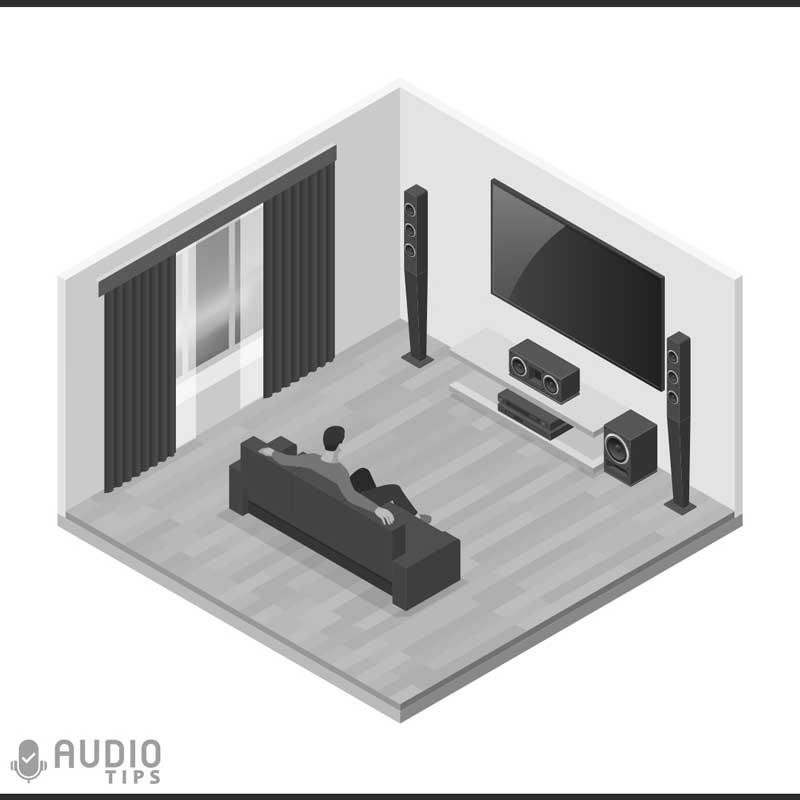
A 3.1 surround sound setup consists of two front channels (left and right speakers), one center channel, and a subwoofer. This center channel provides more depth and clarity and enhances the mid-range frequencies, especially the dialogues.
Start with placing the two main speakers in a stereo setup as described above, but keep the distance slightly on the higher side. Then, keep the center speaker as close to the center of these speakers as possible. If you like, you can move it a little more towards yourself for emphasis on the central sound (especially for dialogue).
The subwoofer can easily be placed anywhere except in closed or partially closed spaces.
4.1 Channel Sound System
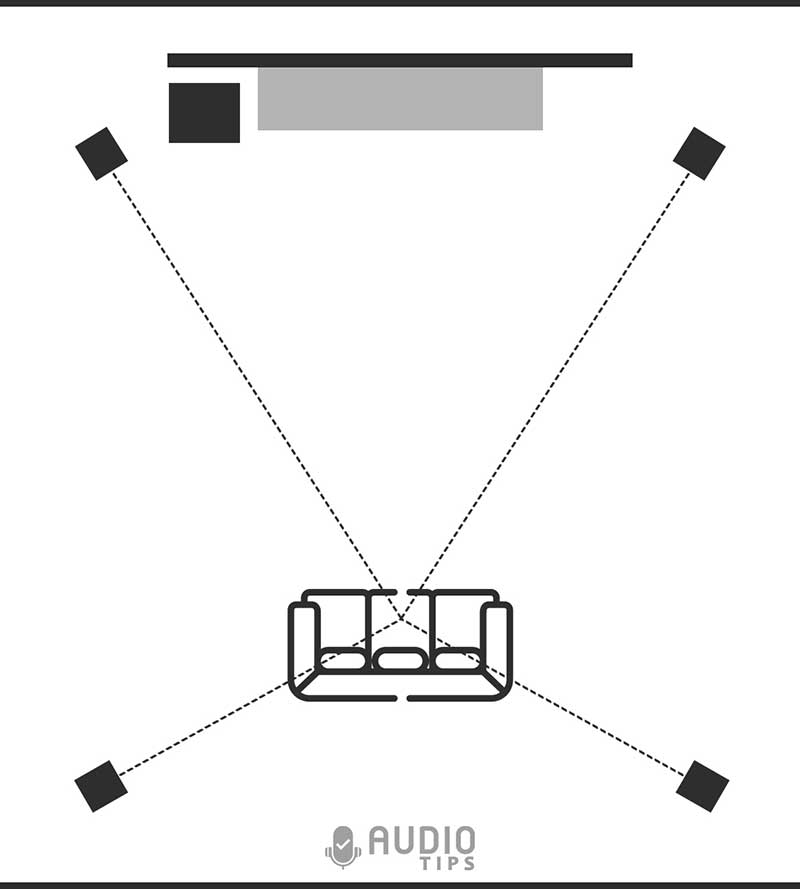
A 4.1-channel setup is similar to a 2.1 setup but with speakers behind you as well. So you can go ahead and place the front speakers on the left and right at an angle toward your listening positions, similar to the stereo setup. The height of the stereo speakers should roughly match your ear level.
For the surround speakers (the two speakers in the back), you have to place them behind your listening position and slightly above your head. And you already know what to do with the subwoofer.
5.1 Channel Surround Sound System
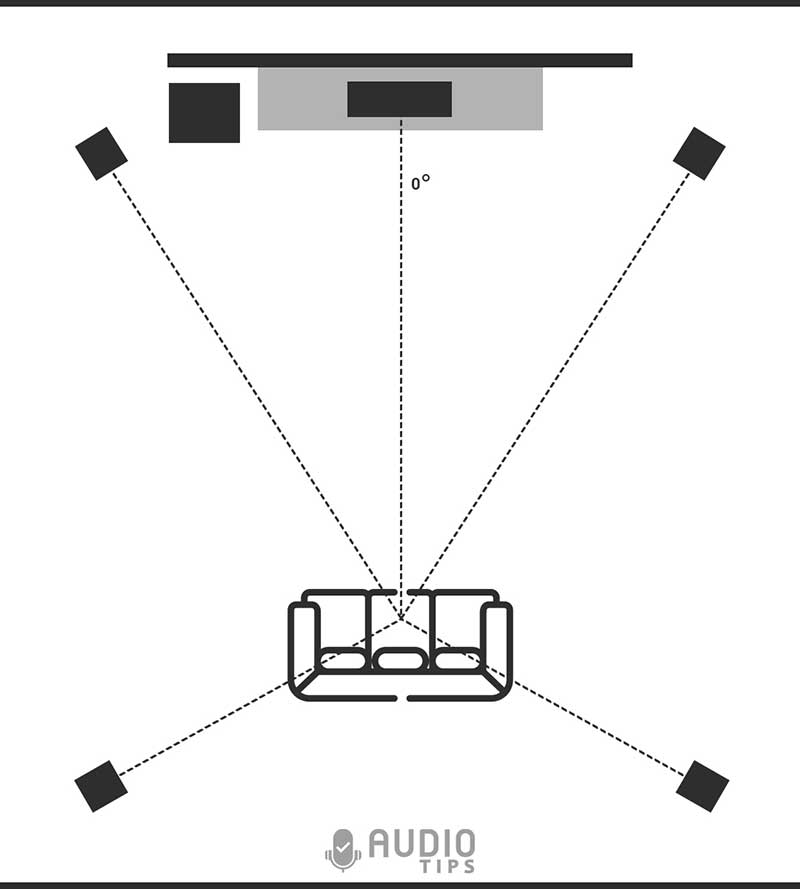
A surround or 5.1-channel sound system is the common entry point into the world of an immersive surround audio experience. This system consists of a stereo system’s usual setup, two extra surround channels on the left and right, and a channel in the center.
You can begin by placing the subwoofer in an appropriate place and the two speakers in a way similar to the 2.1-channel speakers. After that, you can add the center and surround speakers similar to the 3.1 and 4.1 systems, referring to the diagram.
The center channel in a 5.1 surround sound system is primarily responsible for producing the dialogue, which is usually in the middle and upper-middle frequency range.
And it is placed in the center because it gives the feeling that the sound is coming directly from the speaker’s mouth. Hence, it helps in creating a more immersive experience.
Similarly, the addition of two extra speakers (surround speakers) on the back makes the sound image wider. It is primarily responsible for the ambient sounds in the background (for example, the sound of the crowd or the whistles of a bird and other natural noises).
The optimum angle at which you should place the surround speakers is roughly 90-110 degrees with respect to your ears. The height should be slightly above your head. This makes you feel as if you are sitting among the crowd for added realism.
6.1 Channel Sound System
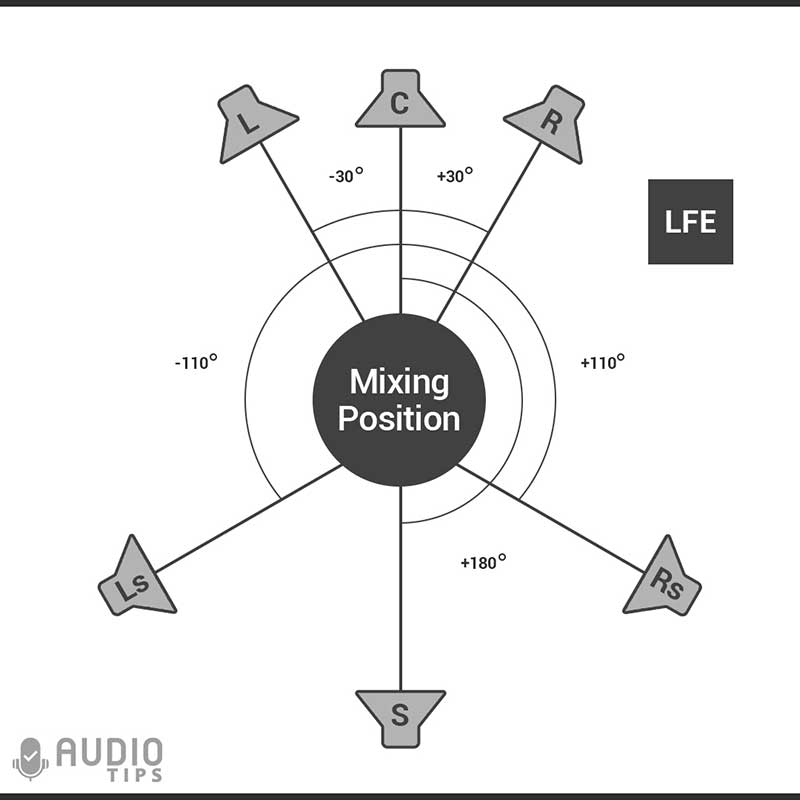
The 6.1 system is essentially a 5.1 configuration with one more speaker. This speaker is situated directly behind the listening position. The sound takes on a new direction as a result of this. The sound appears to be coming from behind you as well.
Despite the fact that the 6.1 sound system is theoretically superior to the 5.1, it’s less popular, as you can get a much better 7.1 system.
7.1 channel Surround Sound System
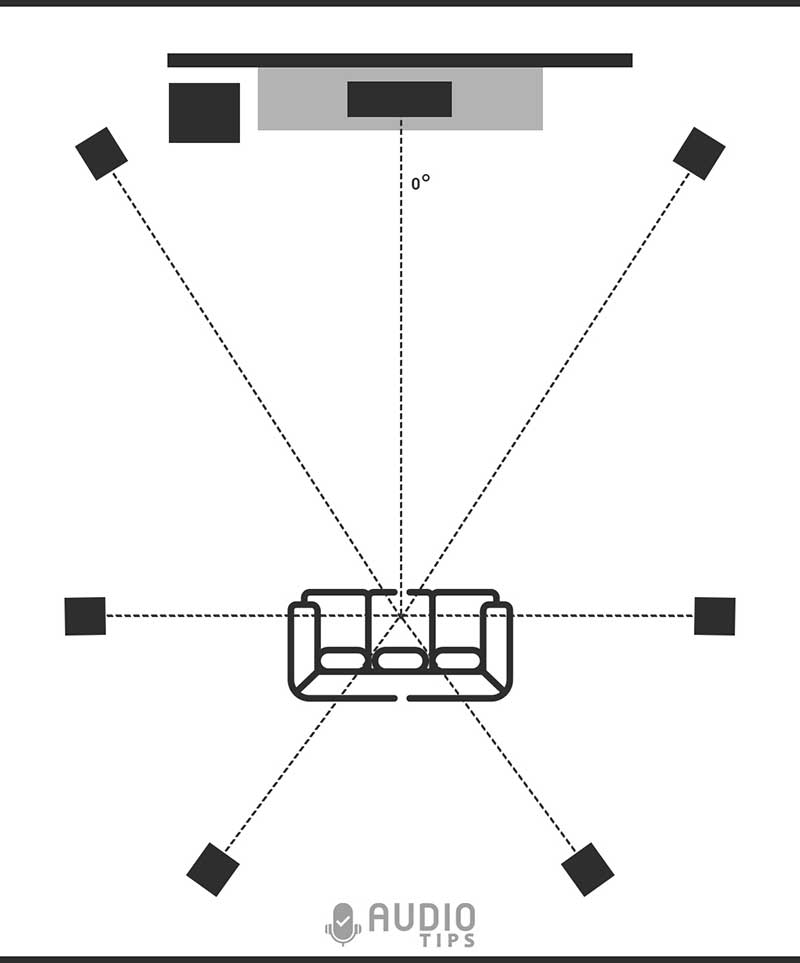
As the name suggests, a 7.1-channel surround system is a slightly more advanced version than the 5.1 and 6.1-channel systems, creating an even more immersive home theatre experience.
Similar to how the 5.1 system had three additional speakers than the typical 2.1 channel setup, a 7.1 channel system adds another two speakers to your arsenal. This adds another level to the realism of the audio and is definitely worth it for movies but less common for music.
You can start with the subwoofer first, and after you have found a suitable place in the room, you can go ahead with the left, right, center, and two surround speakers similar to the 5.1 channel sound system. Just follow those steps and set up the 5.1 layout first.
Now place the two additional speakers at the back of your head at a rough angle of 135–140 degrees behind your viewing position, and the height should be a little above your head when you are seated.
Note: If you cannot place the speakers in the appropriate positions and you must compromise, then don’t move them forward or further apart. If you do so, then there is a chance that the sound produced by the speakers will not fit in with the overall sound image and will destroy the immersion. Instead, you can try to place the speakers further back, closer together, or higher. This won’t affect the sound as much, and your sound image will be closer to what you desire.
Beyond 7.1
The advancement in sound technology certainly does not end with the 7.1 channel system. You can go beyond, such as the 11.1 channel system. It may not be widespread yet, but if you’re a true audiophile, it’s worth checking out. Dolby Atmos can go even beyond this and use just about as many speakers as you’d like!
11.1 Channel Sound System
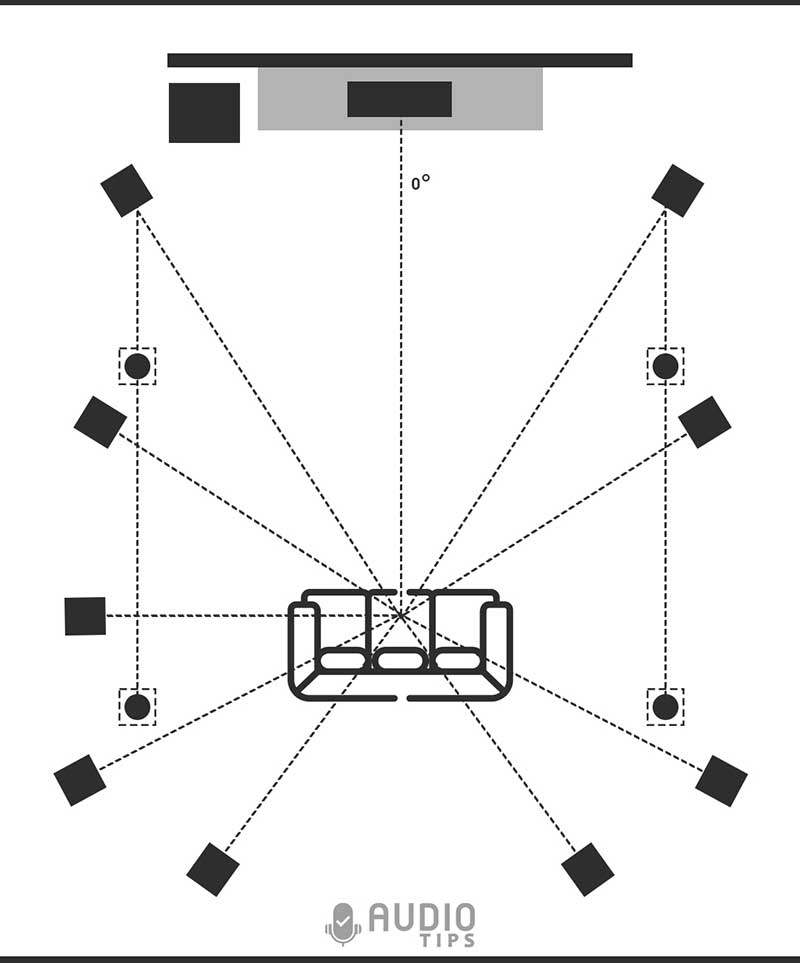
An 11.1 surround sound system is not the usual go-to setup for most home theaters or studios. But, if you can invest in this, then an actual 3D surround sound system will be an excellent return.
All the speakers, including the subwoofer, are placed precisely at the same distance from the listening position. The left, right, and center channels are not placed in a straight line so that their sounds reach the ears simultaneously. This ensures that none of the speakers overpowers the other ones.
The surround speakers are placed similarly to the theatres and create a 3D sound image that produces the best realism and immersion.
Dolby Atmos
If you’d like to go even beyond 11.1, that’s where Dolby Atmos comes in. This is a new technology that allows for a practically unlimited number of speakers to be used in any configuration. The sound produced by each speaker can be individually controlled so that the audio seems to come from anywhere in the room, even above you.
One major advantage of Dolby Atmos is that it seems like the audio is coming from anywhere and everywhere, so it’s the most immersive, but also expensive. If you want to feel like you’re drowning in the music or the movie, then this is the perfect option for you.
Some More Tips and Tricks
Now that you’ve placed your speakers properly, here are some more tips to optimize and tweak your sound experience:
- Automatic sound calibration: Since most people out there don’t have perfect rooms for sound setups and usually build their setups in their living rooms, it becomes tough and time-consuming to sit down and fine-tune each setup component.
- A more straightforward solution is to use microphone receivers to calibrate your sound using software. This software uses microphone receivers to calibrate the sound image automatically and depends on the speaker manufacturers. For example, Yamaha has the YPAO (Yamaha Parametric Room Acoustic Optimizer). See if your existing speakers have any similar calibration tools.
- Experiment with the channels: Even though you will find a lot of guides and manuals, if you still find it difficult to distinguish the dialogues or other sounds, it is best to try different positions yourself. After all, trust your own ears best.
- Get better cables: While it is unnecessary to get super costly ones, you should avoid thin and flimsy ones. Good cables like Mogami and similar brands definitely make a difference in audio quality, especially if you’re investing in a high-end audio setup.
Understanding Stereo, Surround, and Audio Channels
If you’ve ever asked yourself why some soundtracks feel so vast and expansive or why the sounds of explosions appear to originate from all corners of the theater, multiple audio channels are to blame.
When music producers talk about stereo sound, they refer to the relationship as well as the differences between the two stereo channels. Listeners can use this disparity to determine the overall sound’s position (or width) in a recording. Similarly, there are surround audio systems where there are more than two sources of sound (e.g., 5.1 setups, 7.1 setups, and beyond).
Before you set up your speakers, it’s worthwhile going through the different types of sounds so you have a clear picture of what you’ll need to do.
Mono Sound System
Monophonic sound (also called monaural or ‘mono’) is the simplest and the first type of audio reproduction that uses only one channel.
Our brains sense “width” by recognizing variances in audio signals between different speakers. Because mono sound has only one source, similar to a single geometric point, when played through a stereo speaker configuration (such as headphones or common speakers), the same signal is reproduced in both audio channels.
There is no perception of a sound image since there are no differences between the signals. Hence, the sound appears to have no perceptible “width” and originates from a single point.
Mono audio is still widespread these days, such as in the case of radio broadcasting, even though stereo audio is now more commonplace. In specific applications, mono audio is more straightforward and thus more suitable than stereo audio because they require half the channel count of stereo.
Next, we’ll talk about stereo sound. If you’re interested in learning the differences between the two with examples, check out this video below.
Stereo Sound System
It is the standard audio output in most speaker systems, and most modern music is produced in stereo. Stereo sound basically means there are two channels — one on the left and one on the right. These two separate audio output channels make up stereophonic sound.
Even though stereo has only one more audio channel than mono, it allows sound engineers to imbue the recording with a feeling of “width”. When the audio is mixed individually with different effects on each channel, it creates two distinct sides.
A listener’s brain can place sounds in a stereo mode based on distinctions between channels; for example, when the left audio channel sounds louder than the right audio channel, the brain focuses on audio on the left and vice versa. A type of stereo called binaural uses “psychoacoustics” to imitate spatial qualities not present in typical stereo recordings.
Surround Sound System
Surround sound is a sound reproduction technique that uses several audio channels from speakers that surround the listener to improve quality and immersion. Surround channel techniques allow combining more than two channels to the side or behind the listener.
5.1 surround systems combine six separate audio channels. The signals from these channels are then delivered to speakers strategically placed at various points in the listening area, even behind you. Such a setup allows the listener to hear sound from any horizontal direction around them.
The strength of an additional stereo dimension has long been a popular choice for movies, especially in home theatre setups where the extra speakers allow you to feel like you’re a part of the movie. But it’s still uncommon to see such ‘surround sound’ complexity in music.
Ambisonic Sound System
Ambisonics is an advanced version of the surround sound format that includes sound sources above and below the listener along with the horizontal plane in typical surround sound. It allows the listener to perceive sound in all three dimensions, such as a sphere surrounding their ear.
Note that a single channel of mono audio has no length, a dual-track of audio (stereo) has length, but no width, and surround sound (a single plane) doesn’t have height. By adding the ‘height’ component to audio (ambisonic), you can feel that sounds are coming from all around you, even above and below.
For example, in Dolby Atmos, this is accomplished by mounting additional ceiling-mounted speakers. Another benefit to ambisonic audio is that it can automatically be downmixed when played through speakers that are not ambisonic.
Producers can record ambisonic content in many ways. The ideal way would be to use complex mic placements and arrays. But the most prevalent way to produce ambisonic audio is using a piece of software such as Dolby Atmos and its Production Suite. It works by transmitting mono sound individually through different speakers placed separately in a three-dimensional space.
The majority of ambisonic audio is utilized in movies, where the sound output is such that it is synchronized with what’s going on on the screen to increase audience realism. Although this technology is still in its infancy, you may already have experienced this in theaters. If you have more than 7 speakers, you could create an ambisonic system in your home too.
Important Factors For Speaker Placement
An accurate stereo image provides the sense that each sound comes from a distinct location. Consider the sound of a full band emanating from a single point in space, each instrument stacked on top of the others. This won’t sound good at all.
Now, if a sound image is perfect, then the sounds from each instrument appear to originate in a spread-out manner from left to right in front of you. It feels as if the musicians were performing on a stage.
To achieve this level of accuracy and have optimal speaker placement, here are a few factors you should keep in mind:
Speaker Separation
A common question is what distance the speakers should be placed with respect to each other and with respect to you (the listener). The answer is largely dependent on the room’s proportions. A good rule of thumb is to place speakers at the same distance apart as the listener will be seated, forming an equilateral triangle of sorts.
For example, if the listener is 6 feet away from one of the speakers, each speaker should be 6 feet away from the other. It’s okay if you can’t quite hit the equilateral triangle golden rule; just alter your speaker angle to compensate until you find a sweet spot for your ears.
You should avoid placing the speakers with too much distance from each other, as this can cause stereo image problems and phase issues that’ll make it sound muddier than it should.
Speaker Height
Again, to get a proper and immersive sound image, we need to place the speaker where the sound waves can reach our ears directly. This can be achieved by positioning speakers at ear level, which is usually 3 feet above the ground.
Tweeters are the smallest drivers in speakers and produce high frequencies. These should match the ear level. In this way, our ears can perceive the overall sound more clearly. We can use speaker stands to raise the speakers vertically to the proper height.
If you’re not able to get the correct height, you can compensate for this by vertical angles as well (but all speakers don’t support angling). Just point it directly toward where you’ll be sitting.
Reflections
You must have already noticed that when you listen to audio, you aren’t just hearing the sound of your speakers. Speakers do indeed make up a lot of the listening experience, but there are also a lot of reflections mixed in the audio because the sound waves bounce off flat surfaces like the walls, wooden floors, tables, and other objects in the room – creating natural reverb.
So, if there are too many reflections, the sound reaching your ears will become muddier due to the overlapping of different waves. Excess mid-range and low-end frequencies will lead to a sound image with reduced quality.
To reduce the reflections, you need to place each speaker so that there is enough distance between the back and side walls so that the audio can travel properly. Putting couches or carpets can help absorb most reflections. Acoustic treatment using wooden panels on the wall can make a huge difference if you’re looking for a more neutral sound.
The speaker’s proximity to the back wall
The sound is directly affected by the distance between the speakers and the wall. If the distance between the speakers is too short, the sound frequencies will reflect and overlap. As a result, the sound output is muddy, and the sound image is poor.
For a suitable sound image, the distance between a speaker and the wall behind it should be roughly 1-2 feet (a minimum of 6 inches). This reduces phase interference and minimizes reverb and muddy bass frequencies, particularly in speakers with rear ports.
Speaker Isolation
Frequencies like the low-end and sub-bass frequencies can literally rattle the other equipment in your setup. For example, it can resonate with your desk’s wood and any metal items. This can negatively affect the sound, so you should keep the speakers properly isolated.
Ideally, speakers should be placed on a softer surface to attenuate the frequencies that can reverberate poorly. Even if you don’t have enough physical room for your setup, this will allow you to minimize audio damage and boost clarity.
Plus, if you’ve included a subwoofer in your speaker system, you should experiment with different parts of the room to find out what sounds best. Read below to see where it fits, depending on the number of speakers you have.
Room Arrangement
Room arrangement is another essential factor affecting the sound you hear from your speakers. You should make sure that there is the least amount of clutter between you and your speakers.
Specific furniture, like small tables or wardrobes, can reflect audio waves and add reverb. You also need to think about what furniture you’ll use to listen to music and place it between your speakers.
As an example, if your couch is 6 feet long, ensure that your speakers are situated in the center of the couch.
You can experiment with different positions and find the best setup for your room. In the end, you need to make the room comfortable. Otherwise, you might not get inspired enough to do anything with it.
Wrap Up:
That does it for this speaker placement guide. If you have any additional questions about how to setup your speakers, let us know in the comments section below, and we will get back to you as soon as possible.

Hi, my name is Kevin and I’m from Butler, Pennsylvania. I’ve been obsessed with music and audio gear for as long as I can remember. I started this website to help people find professional advice related to a wide range of audio topics. We have a number of Audio Engineers on our team who have been designing and fixing audio gear for decades.
